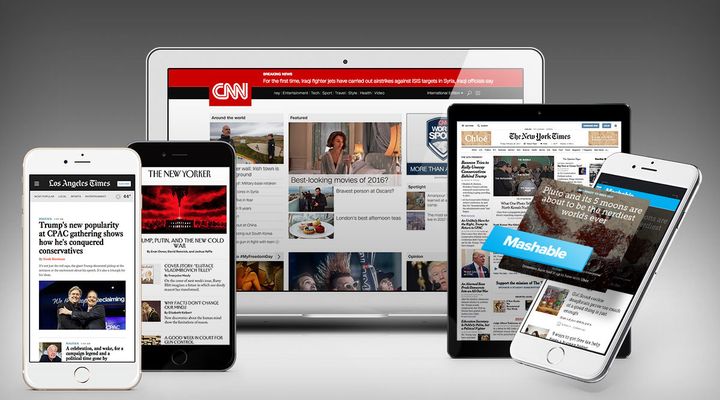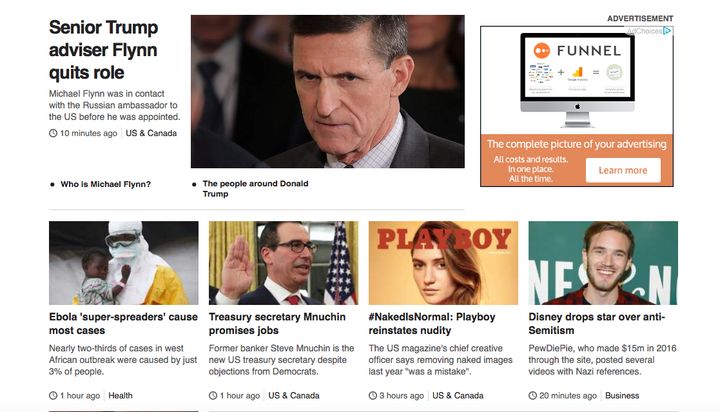
Major news websites haven’t always been known for the quality of their design or their expertise in usability. In the early days of the internet (and even in more recent times, too) it seemed like many news organizations were trying to replicate their print publications directly on the web without considering how the needs of digital readers would differ from those reading on paper.
Fortunately, those dark days are (mostly) behind us. Sure, usability issues still exist on publisher sites, usually in the form of horrific sticky ad overlays, but by-and-large news organizations have invested in making their sites more user-friendly in recent years. Here are five design elements and approaches that we think major news organizations are doing right.
1 - Efficiency of long-scrolling pages
News sites are some of the best employers of long-scrolling webpages, and they’re also great examples of the types of websites this approach works well for. News sites benefit from deep-scrolling layouts because these layouts ensure users can keep scrolling until they find an article that interests them, rather than being forced to click around until they find what they want. It’s also a more immersive experience that encourages content discovery.
The New York Times has a pretty deep-scrolling homepage with loads of content to satisfy any reader.

In general, users prefer to scroll than to click, so in cases where a website’s focus is content discovery, or in cases where a story (about a product, service, company, etc.) is being told, deep-scrolling pages can be an intelligent approach.
2 - Importance of content hierarchy
One of the most important considerations in the designing of news sites is ensuring content is discoverable, and a big factor in discoverability is whether or not users are able to interpret the content being presented to them. Have you ever had the experience of going to a news site and being so overwhelmed by competing content that you threw in the towel altogether? Part of the reason for a bad experience like that is a lack of content hierarchy. The user’s attention needs to be directed to important information, and the layout of the content should make it easy for them to digest that information.
Content hierarchy is an important element in the design of any webpage -- it directs the user’s eye and signals where they should focus attention.

The Atlantic’s homepage features clear content hierarchy -- with bold titles, readable blurbs, and bylines in the magazine’s hallmark red accent color.
3 - Emphasis on shareability
If there’s one thing that most publishers do well, it’s making sure users can easily share their content. They know that the more broadly their content is shared, the more visibility they will have and the more readers they will acquire.
Anyone who produces content (including brands doing content marketing) knows that a big part of making sure your content is successful is in helping it to get discovered. Shareability is a means to discoverability -- a fact that major news sites know well.
Mashable touts the number of shares each piece of content has received (a little social proof never hurt anyone) and prominently displays share buttons.

Broadly has large, appealing share buttons for the networks that are most relevant to their readers.

4 - Stickiness
Stickiness refers to a website’s ability to get visitors to return frequently. Social media sites are very sticky because users are constantly posting new content and updates -- those updates make people feel the need to return frequently to find out what’s new.
Like social media sites, news sites are also naturally sticky as they post new content throughout the day and people naturally turn to them frequently to stay on top of current events. But news organizations also make sure to design around enhancing the stickiness of their sites.
BBC, for example, shows how long ago each article was posted. This serves as a kind of proof to users about how often their homepage is updated with recent news.

CNN takes a similar approach in their “top stories” widget in the right rail. They also have a “breaking news” banner at the top of the site, which probably helps bring users back throughout the day to check if anything’s “breaking.”

Not every website needs to be sticky, but for those that do it’s important to implement design elements that will enhance this effect.
5 - Being mobile-friendly
By now everyone knows the importance of having a site that’s mobile-optimized. Most of us probably also know that designing that site is no small feat. It’s a huge undertaking to figure out how content-heavy sites can be designed for maximum utility on mobile. No one knows that better than news sites, after all they have more content than almost anyone else. Many major news providers have apps, but an app only services those users devoted enough to download it, so a mobile-optimized website is also necessary.
The LA Times and The New Yorker provide users with a functional, enjoyable mobile experience.

There’s a lot to be learned from the way news sites choose to present their content to readers. The chief goals of news sites are to present quality content in a way that makes the content easy and enjoyable to read, and to make it easy for users to find the content they’re interested in. Those goals are aligned closely with the goals of most websites, regardless of industry or vertical. We’d all do well to take note of the specific design elements these major news sites employ to achieve those goals!
To learn more about how your website design can impact usability, visit Blue Fountain Media online.